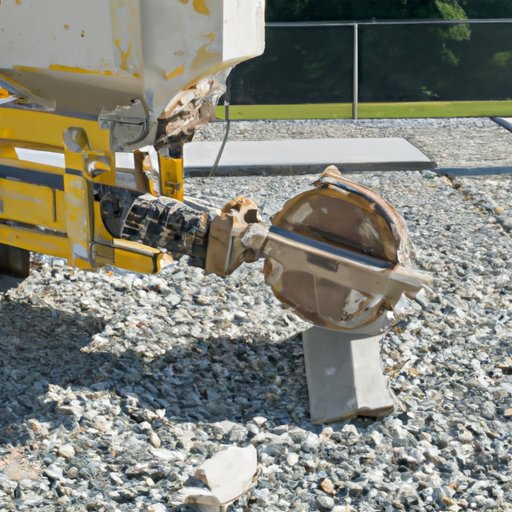
I. Introduction
Homeowners often find themselves with old concrete slab, sidewalk or driveway that needs to be disposed of. Proper disposal of these materials can be a challenge, but knowing the different methods for concrete removal can make the process easier. In this article, we will explore the advantages and disadvantages of various methods for getting rid of concrete, as well as safety tips and precautions to follow.
II. Breaking it Apart
One of the most common ways to remove concrete is by manually breaking it apart with heavy tools such as jackhammers or sledgehammers. This method is inexpensive and straightforward, but it requires a lot of physical work and can take longer. It may also cause damage to the surrounding landscaping and structures.
If you plan on using heavy tools, it is essential to observe safety precautions. Wear protective gear, such as steel-toed boots and gloves, and make sure that the working area is fenced off to prevent accidents.
III. DIY Concrete Dissolver
A concrete dissolver is another cost-effective method for removing concrete. The science behind how it works is that it breaks down the cement binding in the concrete, causing it to dissolve and break apart. There are various types of concrete dissolvers available, but their effectiveness depends on the age and thickness of the concrete.
When using a concrete dissolver, it is crucial to observe safety precautions. The chemicals used in these products are harsh and can irritate the skin and eyes. Avoid inhaling the fumes by wearing a mask, and make sure to follow the manufacturer’s instructions carefully.
IV. Renting a Concrete Crusher
If you have a large concrete removal project, renting a concrete crusher may be an option. This is a heavy-duty machine that can pulverize concrete, making it easy to remove. Renting the equipment is easy and inexpensive, and it can save you the hassle and expense of breaking concrete down manually.
When using a concrete crusher, it is essential to follow the instructions carefully. The equipment is powerful and can cause serious damage if not used correctly. Make sure that the area is clear of people and pets, and use protective gear such as goggles and earmuffs to avoid injury.
V. Hiring a Professional
For larger and more complex projects, it may be best to hire a professional concrete removal company. They have the knowledge and equipment to tackle any job, from small patios to large parking lots. They can also remove concrete safely without damaging the surrounding structures.
When choosing a professional to hire, there are several factors to consider. Look for a company with experience and good reviews from previous clients. Get several quotes, and make sure that the company is licensed and insured. The cost of hiring a professional will depend on the size of the project, but it is often worth it for the peace of mind and the time saved.
VI. Recycling the Concrete
An excellent way to get rid of concrete is by recycling it. This method is environmentally friendly and cost-effective, as most recycling facilities accept concrete for free or at a minimal cost. Recycled concrete can also be used for future construction projects, such as roadways and foundations.
To recycle concrete, contact your local recycling center to find out what their requirements are. They may require that the concrete is clean and does not contain any debris or contaminants. Some recycling facilities also offer pick-up services for large amounts of concrete, making the process even more convenient.
VII. Donating the Concrete
If the concrete is in good condition, consider donating it to a local organization that accepts such materials. Donating concrete is an excellent way to reduce waste and get a tax deduction. Organizations such as Habitat for Humanity and local community gardens often accept concrete donations, which they use for various projects.
Before donating, make sure to contact the organization to find out their requirements and restrictions. They may require that the concrete is clean and does not contain any contaminants. They may also require that the concrete is broken down into manageable sizes before donation.
VIII. Upcycling the Concrete
Another creative way to get rid of concrete is by upcycling it. Old concrete can be used to make beautiful and functional projects such as garden planters, benches, and outdoor tables. Upcycling is not only environmentally friendly but also allows you to create unique and personalized pieces for your home or garden.
To upcycle concrete, search online for design ideas and tutorials. Make sure that the concrete is clean and broken down into manageable sizes before beginning a project. Use protective gear, such as gloves and goggles, when working with concrete to avoid injury.
IX. Conclusion
Getting rid of concrete can be a daunting task, but knowing the various methods for concrete removal can make the process more manageable. Whether you choose to break it apart, use a concrete dissolver, rent a concrete crusher, hire a professional, recycle it, donate it, or upcycle it, make sure to observe safety precautions and select the most suitable method for the project at hand.




